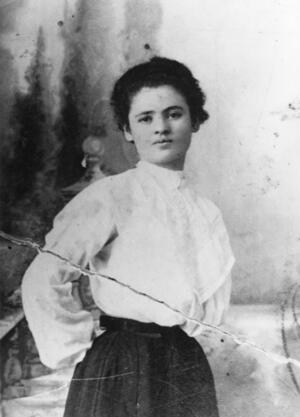Radical activist Clara Lemlich Shavelson dies
Born in 1886, Clara Lemlich Shavelson was already a confirmed radical when she arrived in New York City in 1905. Raised in a religious household in Ukraine, she had defied her parents to learn Russian, traded folk songs for volumes of Tolstoy, and borrowed revolutionary tracts from a sympathetic neighbor. In New York, she found work in a Lower East Side garment shop, and soon began organizing the workers. She quickly became an influential member of the new International Ladies Garment Workers Union (ILGWU), where she protested the virtually all-male leadership's habit of ignoring female union members.
In 1909, Lemlich burst onto a larger political stage when her speech in New York's Cooper Union Hall galvanized young, predominantly Jewish, working girls and set off what became known as the Uprising of the 20,000 (See This Week in History for November 22, 1909). Though the strike was only partially successful, the speech marked the beginning of Lemlich Shavelson's long career in political activism. Her next project was women's suffrage; she helped to found the Wage Earners League for Women's Suffrage, a group distinguished by its working-class membership at a time when most suffrage organizations were composed of more moderate middle-class members. (See This Week in History for April 22, 1912).
Although Lemlich Shavelson's radicalism eventually cost her the paid organizing position with the suffrage league, she remained an outspoken activist, leading the kosher meat boycotts of 1917 and the New York City rent strikes of 1919. After her 1913 marriage and a move to Brooklyn, some of Shavelson's colleagues in the trade union movement felt that she had sold out to middle-class ideals by raising children in the suburbs. However, Shavelson redirected her energies without moderating her radicalism, joining the Communist Party in 1926, and founding the United Council of Working-Class Housewives and then, in 1929, the United Council of Working-Class Women (UCWW). The UCWW argued that consumption was integrally tied to production and that housewives, as consumers, could be an integral part of the class struggle. The Council led meat, milk, and bread boycotts (see This Week in History for May 27, 1935), marched on Washington, and staged rent strikes and sit-ins, winning periodic victories that addressed some of the most pernicious threats to the economic survival of many families during the depression. In addition, Shavelson's insistence on the importance of women's labor in the home laid the groundwork for the later feminist movement's emphasis on gender politics and personal power relations within the family.
After the Second World War, Shavelson became a peace activist, working as an organizer for the American League Against War and Fascism, which opposed nuclear weapons. She also worked for a time in a garment shop, and renewed her activism in the ILGWU, from which she finally retired in 1954. Although she is still hailed as a founder of that union, she was never granted a union pension. At age 81, Shavelson moved into the Jewish Home for the Aging in Los Angeles, where she spent her time convincing the administrators to honor grape and lettuce boycotts, and organizing a union among the orderlies. She was impatient with those who came to record her historic contributions, telling one researcher: "Why are you here interviewing me about what I did? If you want to do something, do something." Shavelson died on July 12, 1982.
Sources: Jewish Women in America: An Historical Encyclopedia, pp. 1238-1241; Annelise Orleck, Common Sense and a Little Fire: Women and Working-Class Politics in the United States, 1900-1965 (Chapel Hill, NC, 1995).




May she rest in peace after living her life with integrity, empowerment and action.